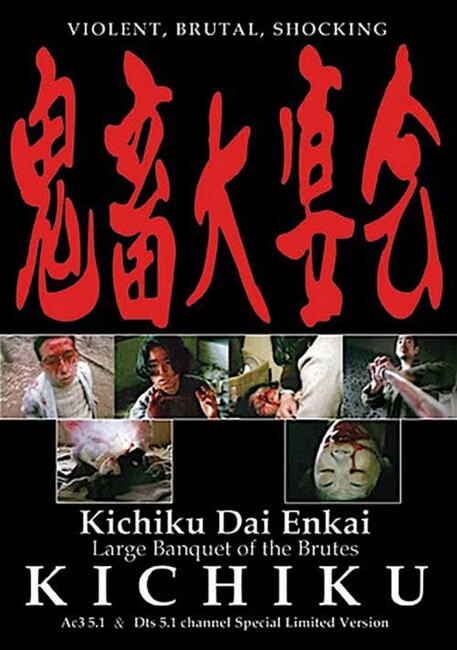aka Kichiku: Banquet of the Beasts
(Kichiku Dai Enkai)
Crew
Director/Screenplay – Kazuyoshi Kumakiri, Producers – Kazuyoshi Kumakiri & Tomohiro Zaizen, Photography – Kiyoaki Hashimoto, Music – Akainu. Production Company – Oni Production.
Cast
Sumiko Mikami (Masami), Shunsuke Sawada (Okazaki), Shigeru Bokuda (Kumagaya), Toshiyuki Sugihara (Sugihara), Kentaro Ogisoas (Fujiwara), Tomohiro Zaizen (Yamane), Yuji Hashimoto (Aizawa)
Plot
Japan in the 1970s. Aizawa, the leader of a group of student radicals, has been jailed. His girlfriend Masami assumes leadership of the group upon his order. She struggles to maintain control and resorts to using her sexuality to make the other men in the group loyal to her. Aizawa then commits suicide in jail, cutting open his stomach. The unity of the group rapidly starts to disintegrate as Masami leads the others to torture a dissident member of the group, something that culminates in an orgy of madness and bloodshed.
Kichiku was made by 23-year-old director Kazuyoshi Kumakiri as a graduation project while as a student at the Osaka Gakudai university film school. Kumakiri made the film over a two-year period using his classmates as actors and crew – indeed, the student dormitory seen in the early parts of the film is also the place where Kumakiri and many of his crew lived. The entire production was made with the equivalent of a $30,000 budget, which Kumakiri and his co-producer Tomohiro Zaizen apparently raised by working construction and as pharmaceutical test subjects. Upon being released, Kichiku became a modest Japanese arthouse hit and found acclaim at various international horror festivals.
The way Kichiku is pitched it comes out sounding like a cross between If… (1968) or Massacre at Central High (1976) and Story of Ricky (1991). It is almost two different films. Or perhaps even more closely the earlier Japanese Ecstasy of the Angels (1972), which similarly focused around a student revolutionary group collapsing into anarchy and sadism. The first half concerns the inner wranglings of a 1970s student radical group. While the cover for the dvd comes with comments like “unflinchingly graphic and extremely violent”, “wallows hip-deep in rivers of blood, brains and intestines,” you wonder for awhile if you have not sat down to watch the wrong film. For at least the first 40 minutes, there is one heated (but clothed) sexual encounter but no violence. Not very much happens during this time and the film seems to be shaping up to be no more than a kitchen sink observation of a student political group.
Where Kichiku comes into its own is its move over into splatter movie territory in the second half. We begin with a brutal extended scene where the group has a dissenter tied up to a tree stump in the forest and repeatedly kick at him. The scene is not so bloody in itself but there is a rawness and a cruelty to what is going on, something that is made all the more unnerving by the unsettlingly mad laugh of gang leader Sumiko Makami, before culminating in the spectacular scene where she blows the kickee’s head off with a shotgun.
This is followed in rapid progression by a series of scenes where:– one person is castrated; a bloodied and badly battered victim is chained up in a bath and forced to eat food out of a can with his mouth, before his friend takes mercy and beats his head in with a plank of wood; Mikami gives one guy a blowjob and then bites his dick off in her mouth; another guy shoves the shotgun up her vagina and then blows her head off, before he is then found playing with her intestines and has his hand and then his head lopped off by a sword wielder; and finally the sword wielder rests his sword hilt upright on the ground and slides his own neck down the blade.
Both the splatter movie label and the acclaim the film found in horror circles has tended to give a false impression of Kichiku being a cartoonish comic-book of a splatter film along the lines of the aforementioned Story of Ricky, Re-Animator (1985) or Peter Jackson’s Bad Taste (1988). There is nothing cartoonish about Kichiku at all – the violence is grim and there is nothing exploitative about it.
The film has also been acclaimed for its political element, yet while this is a strong element of the story this is something that has been overrated. At no point, for example, does one ever find out what cause it is that the student group is rebelling against. Kazuyoshi Kumakiri claims to have gotten his inspiration from the Asama Sanso incident in Japan in 1972 where a group of radical student Marxists took a hostage in a mountain lodge, which ended with bloody consequences. Kumakiri varies widely from the details of the Asama Sanso incident, where in fact the students were shot by the police. However, Kazuyoshi Kumakiri is less making a film about the milieu of radical student politics in the 1970s than he is making an allegory about leadership and conformity and the madness that arises when the control of a loyal group goes awry. This is where the crux of the film lies. You cannot deny its unflinching brutality. This is a work that delves into a particular kind of social madness and determinedly reduces its characters to total barbarism.
Kazuyoshi Kumakiri has gone on to make more than a dozen other films so far, although almost all of these are non-genre dramas and have so far not enjoyed wide release outside of Japan. His two other films of interest are Antena (2004) about sexual sadomasochism and the science-fictional film Freesia: Bullet Over Tears (2007) set in a near-future of legalised revenge killings.


